
Cyberbullying has become an epidemic, affecting millions of children, teens and adults each year. It can be especially damaging to a young person’s self-esteem, social life and academic success.
For these reasons, it’s imperative that teachers get involved — but putting an end to the behavior isn’t an easy task. Here’s how to get started on identifying and preventing cyberbullying in the classroom.
What is Cyberbullying?
Cyberbullying is an umbrella term used to describe harassing behavior and bullying that takes place on the internet.
The Hazelden Betty Ford Foundation describes it as bullying through email, instant messaging, chat room exchanges, website posts or texts sent by cell phone. Cyberbullying typically entails negative, aggressive actions specifically intended to harm the other person.
The increasing use of social media among teens and adolescents has played a role in increased cyberbullying. The communications agency Thornley Fallis points out that most kids are bullied first on social media platforms, which behavior is usually followed up by negative messaging via text or email.
Social media platforms that enable video sharing and posting are hot spots for cyberbullying. End Cyberbullying, a nonprofit anti-bullying organization, writes that Facebook and YouTube are popular with bullies because they harmful or embarrassing video content is easy to upload and distribute.
It’s important to note that cyberbullying can be more emotionally damaging to adolescents than traditional bullying. The Megan Meier Foundation, founded to prevent bullying in all its forms, says cyberbullying is more public than person-to-person bullying, and can spread negative or false information about someone to a greater number of people. Additionally, cyberbullying enables the bully to hide behind a screen name or false identity.
Identify the Signs of Cyberbullying
Knowing the warning signs of cyberbullying can help teachers identify and stop this behavior early on. But since there are many different types of cyberbullying, being aware of different cyberbullying behaviors is the best place to start. The Cybersmile Foundation outlines common types of cyberbullying, which include:
- Harassment — sending abusive messages via phone, social media or email
- Cyberstalking — sending abusive or threatening messages as a result of deep negative or positive feelings towards that person
- Account hacking — hacking a victim’s social accounts to spread false information
- Doxing — distributing a person’s personal information in public spaces without consent
- False profiles — create fake social media account to damage a person’s reputation
- Swatting — calling emergency responders to someone’s house in order to cause the victim panic and fear when armed police suddenly show up
Teachers should learn to recognize changes in student behavior, which can serve as signals of bullying. The Student and Youth Travel Association explains that cyberbullying causes changes in both demeanor and behavior. Specifically, students who are being bullied are more likely to isolate themselves, avoid conversations, experience a decline in grades and appear more distant emotionally and socially. Bullying also creates low self-esteem issues which can result in self-harm — another thing teachers can watch for.
Dr. Matthew Lynch at the education blog, The Edvocate, writes that emotional outbursts and mood swings are telltale signs of emotional stress, the cause of which may be bullying. This is especially true for students who haven’t typically exhibited this behavior in the past.
Similarly, students who seem jumpy or nervous when using phones or computers might be being bullied. When these behaviors are coupled with acting obsessive about using or being on a phone, it is very likely that bullying is occuring, Carolyn Bunting at Internet Matters, a member of the UK Council for Child Internet Safety, writes.
Suddenly changing groups of friends can signify that a student is being bullied too, as he or she may no longer feel they can trust that social environment.
Teens who seem like they’re hiding something from teachers might also be struggling with cyberbullying. Although it can be hard to tell if a student is practicing secrecy, Education Technology suggests that teachers pay attention to how students act around phones and computers. If a student shuts down a computer quickly or puts a phone away as soon as a teacher appears, this could be a sign that the student is either practicing bullying or being bullied.

Prevent Future Cyberbullying
Understanding cyberbullying is key to identifying and ending this harmful behavior. As teachers, however, it’s important to share with your students the importance of ending cyberbullying for good. Here are a few strategies for reducing instances of cyberbullying in your classroom.
Teach Digital Citizenship
Author of The Epic Classroom, Trevor Muir, writes that one of the best ways to prevent cyberbullying is to teach digital citizenship. By speaking out against destructive practices like cyberbullying, students will understand just how serious this issue is.
Moreover, many teachers don’t talk about this issue until it’s already happening, so bringing up the topic earlier in the year might help. Holding discussions in class and sharing statistics can make bullying easier to talk about, which may make students more likely to speak up.
One way to open up discussions about cyberbullying is to show students movies that feature bullies and victims. Tim Woda, cofounder of the digital parenting blog Uknow.com, lists five movies that teach about bullying:
- Cyberbully
- Odd Girl Out
- To Be Fat Like Me
- Boys Don’t Cry
- Bang Bang You’re Dead
Child safety advocate Pattie Fitzgerald adds that a zero-tolerance bullying school policy can help students make kinder, smarter choices online. Teachers need to make it clear to students that any form of harassment or threatening behavior, either in school or online, will be dealt with immediately. An anti-bullying policy and school behavioral code, which specifically outlines acceptable and unacceptable behaviors — will reinforce what is taught in the classroom.

Emphasize Reporting
Cyberbullying thrives if students don’t speak up when they see it happening. That’s why it’s so important to emphasize the benefit of reporting cyberbullying when it happens.
A successful example of a statewide bullying reporting strategy is Safe2Tell Colorado, which was launched after the Columbine massacre. It is an anonymous tip line where teens and adults can share reports of bullying either at school or in the community.
Another idea for reporting cyberbullying comes from Childnet International. This organization emphasizes the importance of capturing evidence of cruel online behavior for use in reporting. Teaching students how to take screenshots and save message threads is an easy way to empower them against abusive behavior.
Plus, teaching the class how to capture such evidence and bring bullies to light is a strong way to dissuade such behavior.
Connectsafely.org points out that there are also built-in tools for reporting bullying on most social media channels. Knowing how to block a person or report their behavior are empowering tools that can help students feel safer and more confident about taking action against cyberbullying. Holding a quick workshop on how to use these social media features can go a long way to ending online bullying before it escalates.
Images by: highwaystarz/©123RF Stock Photo, Wokandapix, Matthew Henry


What do you think?